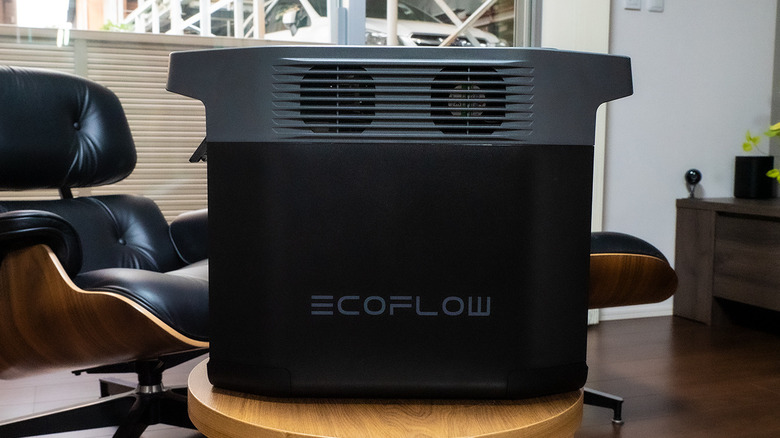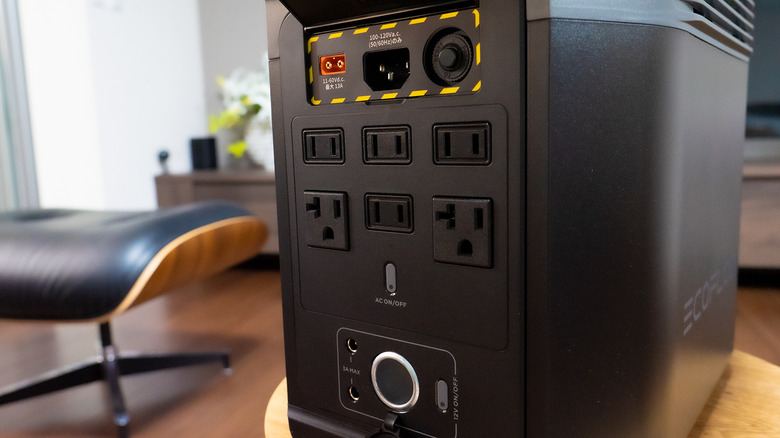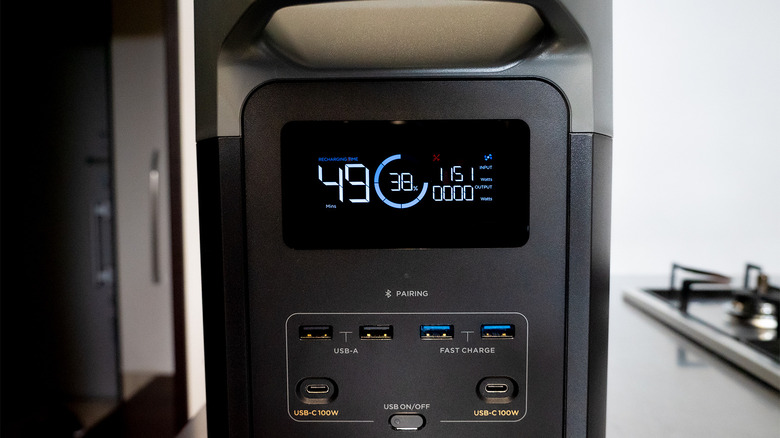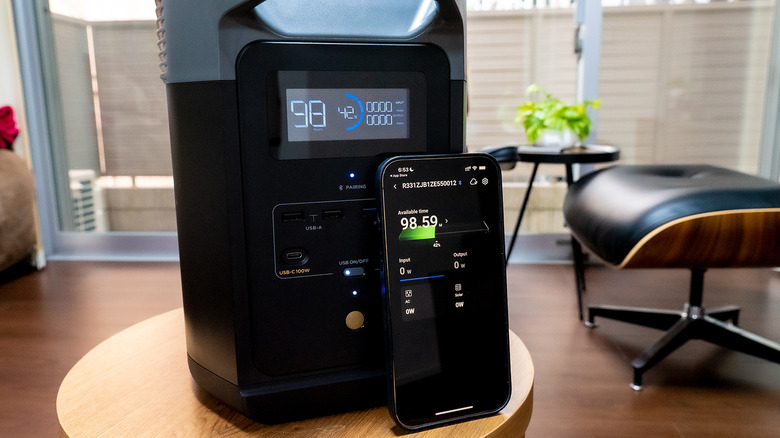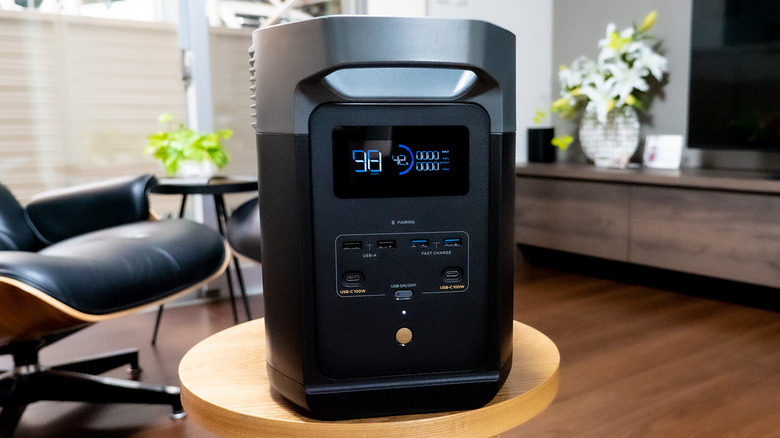EcoFlow Delta 2 Review: Catching Up With The Times
- Remote monitoring and control via app
- Plenty of ports for appliances and devices
- Dual USB-C 100W output
- Can be extended with other EcoFlow batteries
- Handles prevent compact storage in cramped spaces
- New features are old industry standards
- Doesn't have any standout feature
Portable power stations are becoming more popular and more important today as our homes fill up with gadgets and consumer electronics. There are quite a few brands rising to the top in this still-nascent market, and they're mostly competing on design and a few special features here and there. EcoFlow is one of the trailblazers of this industry, and we've reviewed some of the key products it has launched over the past two years or so. Now the brand is coming full circle and going back to its roots, finally upgrading its inaugural power station with features you'd expect today. The new EcoFlow Delta 2 is that blast from the past, and we took it for a ride to see if there is still room for this upgraded pioneer.
You have to give props to EcoFlow for sticking with a recognizable design since its first portable power station launched on Kickstarter in 2019. All of its Delta portable power stations share the same basic appearance, differing only in size or, in the case of the Pro line, wheels. That particular aesthetic somewhat resembles a tall cooler with fixed handles sticking out from the sides, which are actually the front and back of the power station. They make for easier carrying, but the handles also make it impossible to stash the Delta 2 efficiently in cramped spaces.
That was how the original EcoFlow Delta looked three years ago, and that is how the new Delta 2 looks today, as well. There are differences, of course, but they're subtle and almost unnoticeable unless you really look for them. The EcoFlow Delta 2 is larger but lighter, for one. But the biggest difference is that almost all of the ports and connections have been relocated to the front and back of the chassis where the handles are. This minimizes where the cords and cables will stick out and indirectly protects the cords because you can push the power station all the way against a wall.
Battery and output
The EcoFlow Delta 2 also packs a battery upgrade, but it follows the theme of subtle and unnoticeable changes. Compared to the first-gen model, the capacity is similar at 1,024 Wh, but the output has been bumped up a bit to a total of 1,800 watts without the surge. With EcoFlow's proprietary X-Boost technology, that output can go all the way up to 2,200 watts. The most important upgrade, however, is the change of battery type from NCM to LFP — LiFePO4 is considered to be a safer and more stable battery technology, and it's the same kind that's used in electric vehicles.
There are also now 15 output options available on the power station to keep up with the growing demand, even in small houses. The most important here is that the two USB-C ports on the front now support 100 watts of output and the Power Delivery (PD) standard. That's enough to charge hungry laptops like MacBook Pros, for example, and everything in between. Like before, there are dedicated buttons to turn each group of power output on or off, but the button on the front has been given a new color to make it more visible even in the dark.
The back of EcoFlow Delta 2 has all of the AC and DC output ports, as well as a flap that covers the two input options that we'll get to later. Depending on your model, you'll have four or six AC outlets with a total 1,800-watt output or 2,700-watt surge, enough for even a microwave or small fridge. DC output options include two barrel-type ports and a car charger, which is also hidden behind a flap of its own.
If that 1,024 Wh capacity sounds insufficient, you can expand the Delta 2 model's power if you have other EcoFlow products lying around. In particular, an EcoFlow extra battery kicks it up to 2 kWh, while hooking it up to the larger EcoFlow Delta Max will produce a total of 3 kWh of power. At that point, you do lose a bit of the portability, but there will always be emergency cases where you'll need more juice in the same place, like during a power outage at home.
Charging
While these portable power stations save you from dangerous and expensive gasoline, they will need to be recharged at some point. When that time comes, you do have a variety of options available, depending on where you're at and what's available. If you're out on the road, charging via a car charger might be the most convenient, but it's also the slowest and least efficient. Unless you also carry solar panels with you, however, this is the only option when you're really living outdoors and off the grid.
Most people will go with the AC route, plugging the Delta 2 into a wall socket while there's power available. Not only is it the most common, but it is also the method that offers the best speed potential — we were able to get over 1,100 watts charging the unit. If X-Boost pushes the output beyond the normal capacity, its parallel is X-Stream for incoming power. This technology lets the Delta 2 charge about seven times faster than the competition, at least according to EcoFlow's numbers. To put that in practical terms, it takes around an hour and 20 minutes to charge the Delta 2 from zero to full via AC. Given the battery's capacity, that's quite some speed.
Portable power stations like these, however, also open up an opportunity to make an important change. Unlike traditional generators, they don't need fuel to function. More importantly, however, they don't even need to be plugged into a wall socket to be charged. Like many of its relatives, the EcoFlow Delta 2 can be charged via solar panels, which the company naturally sells, as well. Admittedly, it's not the fastest route compared to AC — even without X-Stream — taking three hours to charge the power station with 500 watts of solar power input. It does, however, help in creating a greener system where you won't increase the world's carbon emissions just because you need emergency power.
Controls and special features
Another major feature of the Delta 2 is wireless connectivity. The power station can connect to your smartphone directly via Bluetooth or through your home Wi-Fi network. In either case, a dedicated EcoFlow mobile app opens the doors to remote access to the power station. Not only can you see the status and remaining capacity of the Delta 2, but you can also control it from the convenience of a mobile device. You can, for example, toggle those output ports on or off without having to walk over and press a button. You can also control the charging speed or its output frequency, as well as other functions of the machine. It is also the only way you'll be able to turn off that loud beep if it has started to get on your nerves.
While this might be a huge upgrade for the Delta 2 compared to the first Delta, it isn't exactly groundbreaking in the grand scheme of things. Considering the EcoFlow Delta launched back in 2019, it's not really surprising that it didn't come with these wireless features. That only started popping up last year, and it has become a staple of most portable power stations today. Almost all of EcoFlow's other Delta models have it, so it's really just a matter of the Delta 2 finally catching up.
The EcoFlow Delta 2 max also has an Emergency Power Supply (EPS) capability. In a nutshell, this lets the power station act as an intermediary between your mains and your appliances, and it will automatically switch to battery power when the grid suddenly goes down. This can be especially useful when the Delta 2 is paired with an extra battery, but it does require that the power station is always plugged in, ready to switch at a moment's notice.
Verdict
On the surface, there is a lot to like about the new EcoFlow Delta 2. The 1 kWh battery capacity and 1,800-watt output can handle most of your charging needs, from smartphones to laptops, many times over. X-Boost technology can make it go even further to power appliances you might find essential during a blackout. There is a bit of heft to it, of course, at 27 pounds, which is to be expected for a battery this big. The handles make carrying a little bit easier, but it also makes it harder to pack it up in tight spaces because of the protruding parts. EcoFlow grew a little bit wiser this time and made cable management more convenient by having all of the ports on either the front or back sides only. Everything about the Delta 2 is a refinement of the original, which is, unfortunately, also its biggest problem, as well.
This new portable power station doesn't exactly offer anything new, at least not compared to any EcoFlow product other than the original Delta. It does fill in the need for a 1,000 Wh power station that has feature parity with other Delta models, but that's pretty much all there is to it. LiFePO4 or LFP batteries are now the standards for these power stations, and being able to remotely control them with a mobile app is also a common feature these days.
For those already hooked on EcoFlow's ecosystem, the Delta 2 Portable Power Station admittedly fills a need and conveniently slots in between the Delta Mini and the Delta Max. More importantly, it adds yet another option in the market for clean, safe, and green power, especially when paired with EcoFlow's solar panels. Unfortunately, even at a sweet price of $999, the Delta 2 will have some problems standing out from the competition, especially when it barely offers anything special for people to remember it by. From September 16 to 23, 2022, customers who purchase Delta 2 will also get the $69 Delta 2 Waterproof Bag for free, so there's that.
